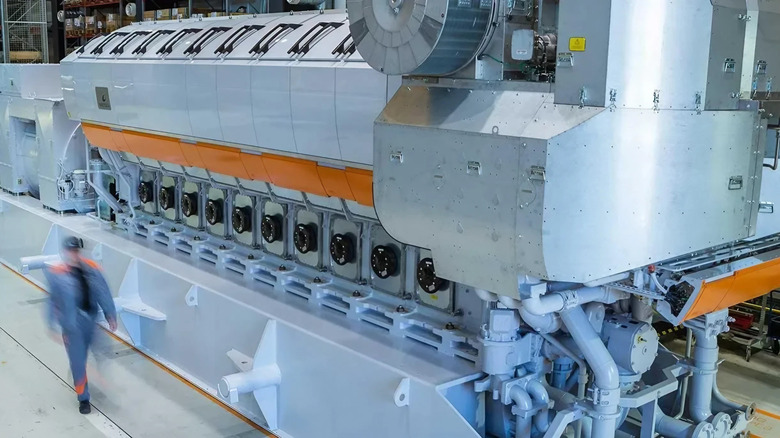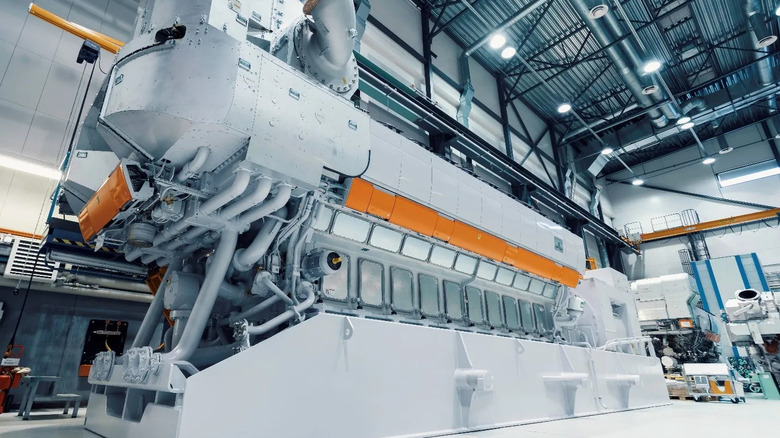What's The Most Efficient 4-Stroke Diesel Engine Ever Built & What Does It Power?
Finnish manufacturer Wärtsilä introduced an engine back in 2015 that was so good, it snagged a Guinness World Records title for being the most efficient four-stroke diesel engine shortly after its debut. Called the Wärtsilä 31, the engine boasted a ridiculously low diesel consumption of just 165 grams per kilowatt-hour, a figure that was significantly better than any other four-stroke diesel on the market at the time.
Of course, as you can tell from the image above, this isn't an automotive engine. The largest V-16 variant is a colossal piece of engineering that stands over 13 feet tall, weighs a hefty 85 tons, and has a displacement of 519.3 liters — though those numbers still aren't enough to land it on the list of the world's largest engines.
The Wärtsilä 31 achieves that efficiency thanks to cutting-edge fuel and air injection systems, along with variable valve timing to squeeze every last drop of power from its fuel. What really sets it apart is its insane flexibility. It was designed from the ground up to come in three versions, a straight diesel version, a dual-fuel (DF) model, and a spark-ignited gas (SG) variant. This multi-fuel capability gives operators the freedom to run the engine on everything from very light to heavy diesel, as well as various qualities of gas.
What does it power?
The Wärtsilä 31 primarily serves the offshore, cruise, and ferry marine segments. Specifically, it's known to power vessels like fishing boats, catamarans, and even specialized cable-laying ships. Its combination of high power density and operational flexibility makes it a perfect fit for such ships. Its low noise emissions have also made it a favorite on luxury cruise ships. The choice is one element in the broader discussion of which engines are used aboard cruise ships.
This engine has perhaps made the biggest splash in the commercial fishing industry. Some advanced fishing vessels like stern trawlers operate for up to 350 days a year, so fuel consumption has a massive impact on their profitability — something this engine helps optimize. In fact, Wärtsilä was so confident in the engine's efficiency, that it developed an entirely new, optimized stern trawler design built around it, announcing it in 2017.
Another major reason for its popularity is that the engine was built for endurance and lower operational costs. Its first required maintenance comes after it has run for 8,000 hours, which is a massive improvement over the typical 2,000-hour interval for similar engines. Its modular construction also allows for the replacement of individual cylinder components, which simplifies maintenance further. That said, the engine's application isn't strictly limited to the sea, as it can be installed in land-based power plants for electricity generation as well.
How does the engine hold up today?
A full decade after its record-setting debut, the Wärtsilä 31 still reigns supreme, though engines like China's record-breaking Weichai WP13H have also made headlines. It helps that Wärtsilä hasn't been sitting still, as the company has been continuously upgrading the platform.
In late 2020, the dual-fuel 31DF model received a power-up, increasing its output range to 4.6 to 12 MW while impressively staying within the same physical dimensions. Not content to stop there, Wärtsilä rolled out another upgrade in early 2023, this time for the diesel version. That update boosted its power range to 5.2 to 10.4 MW, giving it the highest power per cylinder for engines with that particular bore size.
Over the years, Wärtsilä has continued to focus on improving power generation, increasing cost efficiency, and adapting to new fuels. The company is also doubling down on sustainability. For instance, the dual-fuel engine has an optional NextDF feature that can slash methane slip by up to 85% when operating on gas. These engines can also be integrated into smart hybrid systems with batteries.


